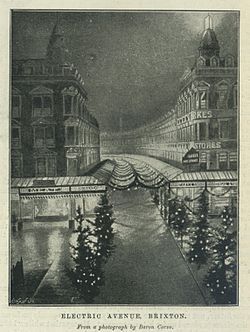Electric Avenue


Electric Avenue is a street in Brixton, London. Built in the 1880s, it was the first market street to be lit by electricity. Today, the street contains several butchers and fish mongers and hosts a part of Brixton Market, which specializes in selling a mix of African, Caribbean, South American and Asian products. It is located just around the corner from Brixton tube station (1972). The elegant Victorian canopies over the pavements survived until the 1980s.
In popular culture
The road gave its name to Eddy Grant's 1983 single "Electric Avenue", which reached #2 on both the UK and U.S. singles charts.[1] The song was inspired by the 1981 Brixton riot.
Bombing
On 17 April 1999 the neo-Nazi bomber David Copeland planted a nail bomb outside a supermarket in Brixton Road with the intention of igniting a race war across Britain.[2] A market trader was suspicious and moved it round the corner to a less crowded area in Electric Avenue. The bomb went off, injuring 39 people.
Notes
- ^ Laurel A. Saunders (2007). I Have Wings, So Why Am I Here?. Trafford Publishing. p. 145. ISBN 978-1-4251-1936-2.
- ^ "Profile: Copeland the killer". BBC News. 30 June 2000. Retrieved 16 April 2011.
{{cite web}}: Italic or bold markup not allowed in:|publisher=(help)
References
51°27′44″N 0°06′50″W / 51.46229°N 0.11377°W
